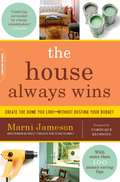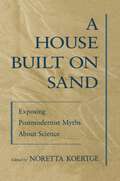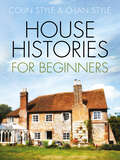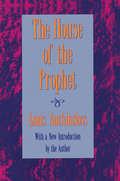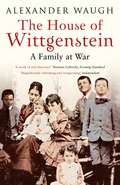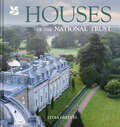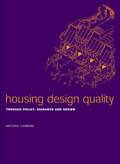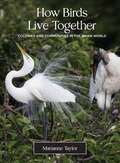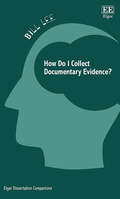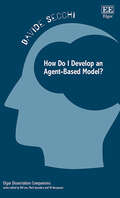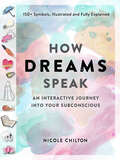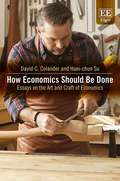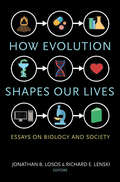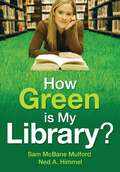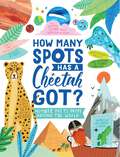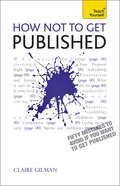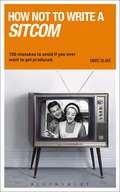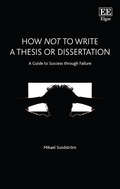- Table View
- List View
The House Always Wins: Create the Home You Love-Without Busting Your Budget
by Marni JamesonVia her weekly syndicated column, "At Home with Marni Jameson,” Jameson is one of the funniest, most eagerly read purveyors of home-improvement advice. The House Always Wins, her compulsively readable, zanily humorous, yet completely practical guide hailed by critics, now has even more moneysaving advice on creating, living in, and even selling a beautiful, livable home.
The House Always Wins: Create the Home You Love-Without Busting Your Budget
by Marni JamesonMore than 7 million readers of Marni Jameson's weekly home design column have already discovered how Jameson entertains and inspires, while imparting well-researched and personally validated DIY advice. Now, in her first-ever book on home improvement, she offers a compulsively readable, zanily humorous, yet also completely practical guide to a headache-free home makeover for everyone decorating a new house or updating an old one.Jameson has designed, built, and decorated three homes from the ground up. In The House Always Wins, she brings us along as she decorates, furnishes, and landscapes her current home. Though rooted in her own experience, this is no navel-gazing memoir. Rather, Jameson is like a favorite sister who has learned it all the hard way and is now here to prompt and inspire you to figure out your own personal style, make a design plan, and create your (almost) perfect dream home-one step at a time. With Jameson as our guide, we navigate through the seemingly endless maze of choices and decisions every home improver faces: wall color, flooring, cabinetry, window treatments, furniture, bargain hunting, home accessories, rugs, kids -- spaces, special purpose rooms (like the garage and guest, laundry, and mud rooms), landscaping, outdoor living spaces-and that's just to start. Along the way, Jameson injects insights into the relationships and realities that dog every home improvement project. She also pauses to share hard-won secrets and money-saving tips distilled from her own redecorating experience and from interviews with dozens of renowned home-design experts.For anyone dealing with budgets, time constraints, unreliable contractors, a cheap spouse, kids, and pets-and who would appreciate having someone to commiserate with about the unattainable perfection featured in glossy magazine spreads-The House Always Wins will comfort (it can always be worse), inspire (who knew?!), and be absolutely indispensable.
A House Built On Sand: Exposing Postmodernist Myths About Science
by Noretta KoertgeCultural critics say that "science is politics by other means," arguing that the results of scientific inquiry are profoundly shaped by the ideological agendas of powerful elites. They base their claims on historical case studies purporting to show the systematic intrusion of sexist, racist, capitalist, colonialist and/or professional interests into the very content of science. Physicist Alan Sokal recently poked fun at these claims by foisting a sly parody of the genre on the unwitting editors of the cultural studies journal Social Text touching off a still unabated torrent of editorials, articles, and heated classroom and Internet discussion. This hard-hitting collection picks up where Sokal left off. The essayists offer crisp and detailed critiques of case studies offered by the cultural critics as evidence that scientific results tell us more about social context than they do about the natural world. Pulling no punches, they identify numerous crude factual blunders (e.g. that Newton never performed any experiments) and egregious errors of emission, such as the attempt to explain the slow development of fluid dynamics solely in terms of gender bias. Where there are positive aspects of a flawed account, or something to be learned from it, they do not hesitate to say so. Their target is shoddy scholarship. Comprising new essays by distinguished scholars of history, philosophy, and science (including Sokal himself), this book raises a lively debate to a new level of seriousness.
House Histories for Beginners
by Colin Style O-lan StylePopular television programmes highlight the satisfaction that can be gained from investigating the history of houses, and there is always plenty of interest in the subject, with archives becoming ever more accessible with access to the internet.As the subject covers a broad field, the authors have set out to include advice on those aspects that usually apply to a project and others that will be of particular use for beginners. The reader is guided through every stage of research, from the first exploration of the archives to the completion of the task. Suggestions are also included on how to present the findings – a house history makes a very attractive gift.The authors describe how to deduce the age of a property (it is very seldom directly recorded when a house was built) and characteristics of research on particular types of property – such as cottages, manor houses, inns, mills, former church properties, and farms – are discussed. In one example, research demonstrated that a farm was likely to have been a Domesday manor – a fascinating discovery achieved using records accessible to any beginner.
The House of the Prophet
by Louis AuchinclossThe House of the Prophet is Louis Auchincloss's searching novel of Felix Leitner, one of the most influential men of his time. Political philosopher, columnist, adviser to American presidents, Leitner will doubtless bring to many readers' minds the late Walter Lippmann, portrayed in the fine biography by Ronald Steel. Indeed, in his new introduction, Auchincloss makes plain that "the idea of writing a novel inspired by, though by no means based upon, the life of Walter Lippmann was unlike any fictional idea that I have had before or since." He candidly adds, "I was always perfectly aware the Felix Leitner, the protagonist of The House of the Prophet, would be instantly related to Walter Lippmann, and I had no objection to this." Whether considered on its own merits or as a major statement on Lippmann, this volume deserves close scrutiny.
The House of the Prophet
by Louis AuchinclossThe House of the Prophet is Louis Auchincloss's searching novel of Felix Leitner, one of the most influential men of his time. Political philosopher, columnist, adviser to American presidents, Leitner will doubtless bring to many readers' minds the late Walter Lippmann, portrayed in the fine biography by Ronald Steel. Indeed, in his new introduction, Auchincloss makes plain that "the idea of writing a novel inspired by, though by no means based upon, the life of Walter Lippmann was unlike any fictional idea that I have had before or since." He candidly adds, "I was always perfectly aware the Felix Leitner, the protagonist of The House of the Prophet, would be instantly related to Walter Lippmann, and I had no objection to this." Whether considered on its own merits or as a major statement on Lippmann, this volume deserves close scrutiny.
The House of Wittgenstein: A Family At War
by Alexander WaughThe Wittgenstein family was one of the richest, most talented and most eccentric in European history. The domineering paternal influence of Karl Wittgenstein left his eight children fraught by inner antagonisms and nervous tension. Three of his sons committed suicide; Paul, the fourth, became a world-famous concert pianist (using only his left hand), while Ludwig, the youngest, is now regarded as one of the greatest philosophers of the twentieth century. In this dramatic historical and psychological epic, Alexander Waugh traces the triumphs and vicissitudes of a family held together by a fanatical love of music yet torn apart by money, madness, conflicts of loyalty and the cataclysmic upheaval of two world wars.
Houses of the National Trust
by Lydia Greeves National Trust BooksFully revised and updated edition of the classic, stunningly illustrated guide to the cream of Britain’s historic country houses cared for by the National Trust, encompassing both interior and exterior design.
Housing Design Quality: Through Policy, Guidance and Review
by Matthew CarmonaThis book directly addresses the major planning debate of our time - the delivery and quality of new housing development. As pressure for new housing development in England increases, a widespread desire to improve the design of the resulting residential environments becomes evermore apparent with increasing condemnation of the standard products of the volume housebuilders.In recent years central government has come to accept the need to deliver higher quality living environments, and the important role of the planning system in helping to raise design standards. Housing Design Quality focuses on this role and in particular on how the various policy instruments available to public authorities can be used in a positive manner to deliver higher quality residential developments.
Housing Design Quality: Through Policy, Guidance and Review
by Matthew CarmonaThis book directly addresses the major planning debate of our time - the delivery and quality of new housing development. As pressure for new housing development in England increases, a widespread desire to improve the design of the resulting residential environments becomes evermore apparent with increasing condemnation of the standard products of the volume housebuilders.In recent years central government has come to accept the need to deliver higher quality living environments, and the important role of the planning system in helping to raise design standards. Housing Design Quality focuses on this role and in particular on how the various policy instruments available to public authorities can be used in a positive manner to deliver higher quality residential developments.
How Birds Live Together: Colonies and Communities in the Avian World
by Marianne TaylorA beautifully illustrated exploration of the ways birds cohabitFeaturing dramatic and delightful wild bird colonies and communities, How Birds Live Together offers a broad overview of social living in the avian world. From long-established seabird colonies that use the same cliffs for generations to the fast-shifting dynamics of flock formation, leading wildlife writer Marianne Taylor explores the different ways birds choose to dwell together.Through fascinating text, color photos, maps, and other graphics, Taylor examines the advantages of avian sociality and social breeding. Chapters provide detailed information on diverse types of bird colonies, including those species that construct single-family nests close together in trees; those that share large, communal nests housing multiple families; those that nest in tunnels dug into the earth; those that form exposed colonies on open ground and defend them collectively, relying on ferocious aggression; those that live communally on human-made structures in towns and cities; and more. Taylor discusses the challenges, benefits, hazards, and social dynamics of each style of living, and features a wealth of species as examples.Showcasing colonies from the edge of Scotland and the tropical delta of the Everglades to the Namib Desert in Africa, How Birds Live Together gives bird enthusiasts a vivid understanding of avian social communities.
How Birds Live Together: Colonies and Communities in the Avian World
by Marianne TaylorA beautifully illustrated exploration of the ways birds cohabitFeaturing dramatic and delightful wild bird colonies and communities, How Birds Live Together offers a broad overview of social living in the avian world. From long-established seabird colonies that use the same cliffs for generations to the fast-shifting dynamics of flock formation, leading wildlife writer Marianne Taylor explores the different ways birds choose to dwell together.Through fascinating text, color photos, maps, and other graphics, Taylor examines the advantages of avian sociality and social breeding. Chapters provide detailed information on diverse types of bird colonies, including those species that construct single-family nests close together in trees; those that share large, communal nests housing multiple families; those that nest in tunnels dug into the earth; those that form exposed colonies on open ground and defend them collectively, relying on ferocious aggression; those that live communally on human-made structures in towns and cities; and more. Taylor discusses the challenges, benefits, hazards, and social dynamics of each style of living, and features a wealth of species as examples.Showcasing colonies from the edge of Scotland and the tropical delta of the Everglades to the Namib Desert in Africa, How Birds Live Together gives bird enthusiasts a vivid understanding of avian social communities.
How Do I Collect Documentary Evidence? (Elgar Dissertation Companions)
by Bill LeeThis insightful book introduces a range of innovative strategies for collecting contemporary textual documentary evidence. Featuring insightful vignettes, it comprises a critical guide to the various challenges of collecting documents to realize each of those strategies.Bill Lee explains how the epistemological and ontological assumptions of the researcher may influence their choice of a research strategy for surveys, comparative case studies, critical narratives and constitutive discourses when collecting documents. The book offers examples of published studies in the different branches of management and considers the strengths and weaknesses of grounding research studies in the collection of documentary evidence. Providing step-by-step guidance for the operationalization of a chosen research strategy for collecting documents, it also builds a crucial list of different repositories of documents that might be employed in research.This cutting-edge book presents useful guidance and illuminating insights for business and management students of all levels hoping to improve their use of documents in dissertations and research projects. It will also be useful for researchers utilizing documentary evidence for the first time.
How Do I Conduct Ethnographic Research? (Elgar Dissertation Companions)
by Hugo Letiche Ivo De Loo Jean-Luc MoriceauProviding indispensable guidance to how to engage in and carry out ethnographic research, this book highlights the potential advantages and possible pitfalls of this type of qualitative studies. Hugo Letiche, Ivo De Loo and Jean-Luc Moriceau paint a full picture of this fascinating research approach, focusing on its adaptability in the field, when researchers become actively involved with those who they are researching.How Do I Conduct Ethnographic Research? addresses three forms of ethnographic analysis: ethnography, autoethnography, and netnography. Each chapter begins with specific aims to be addressed, and is concluded with helpful exercises to strengthen both one’s theoretical and practical academic skills. Stressing the role of researcher choice-making, this timely book aids the reader in devising a unique approach that best suits the context of their research.This book is crucial for postgraduate students of business and management, marketing, strategy and organization, as well as related subject areas such as finance and human resource management. Those who are new to ethnographic research will additionally find this guide to be invaluable.
How Do I Develop an Agent-Based Model? (Elgar Dissertation Companions)
by Davide SecchiThis clear and coherent book introduces agent-based modelling (ABM) to those who are not familiar with nor have been previously exposed to computational simulation. Featuring examples, cases and models, the book illustrates how ABM can, and should, be considered as a useful approach and technique for the study of management and organisational systems.Davide Secchi begins by explaining what ABM has to offer as opposed to other techniques, emphasising its suitability to the study of complex social systems. While dissecting the core components of the approach, he introduces key elements and mechanisms with a practice oriented approach rather than insisting solely on logic and theory. With an emphasis on applications and using examples from NetLogo — one of the most widely used agent-based software platforms — the book guides the reader through a step-by-step process on how to develop a computational simulation.Featuring a hands-on applied approach that makes a difficult topic easy for non-modellers, How Do I Develop an Agent-Based Model? will be a key resource for business and management Masters-level students embarking on a dissertation project. It will also be a useful reference for PhD students in the field, as well as a starting point for academics who would like to begin using ABM in their research.
How Dreams Speak: An Interactive Journey into Your Subconscious (150+ Symbols, Illustrated and Fully Explained)
by Nicole ChiltonPeek into your subconscious by learning to interpret 150 common dream symbols, beautifully illustrated in watercolor..
How Economics Should Be Done: Essays on the Art and Craft of Economics
by Huei-Chun Su David C. ColanderDavid Colander has been writing about economic methodology for over 30 years. His pragmatic approach sees applied policy methodology as rooted in what economists actually do, not in what methodologists say they should do. It sees applied policy methodology as constantly evolving as analytic and computational technology changes, evolving far too fast to be subject to any rigid scientific methodology. That problem is that economists generally think of applied policy analysis as applied science. Colander argues that using a scientific methodology to guide applied policy undermines good policy analysis. Instead, he contends that economists should use a much looser engineering methodology that blends science, heuristics, inescapable moral judgments, and creativity into what he calls the art and craft of economics. Here, Huei-chun Su has selected seventeen of Colander’s articles that spell out and capture his arguments at various levels – some formal academic articles dealing with cutting edge methodology, and some more popular articles making the case for his approach. An original introduction and annotated bibliography serve as excellent resources for further exploring his arguments. Clear, well-structured, and written in plain English with little jargon, the book is approachable and suitable for anyone interested in the current and future state of economics and the economics profession. This includes students at any level as well as methodologists, applied economists, historians and critics of modern economics.
How Evolution Shapes Our Lives: Essays on Biology and Society
by Jonathan B. Losos Richard E. LenskiIt is easy to think of evolution as something that happened long ago, or that occurs only in "nature," or that is so slow that its ongoing impact is virtually nonexistent when viewed from the perspective of a single human lifetime. But we now know that when natural selection is strong, evolutionary change can be very rapid. In this book, some of the world's leading scientists explore the implications of this reality for human life and society. With some twenty-three essays, this volume provides authoritative yet accessible explorations of why understanding evolution is crucial to human life—from dealing with climate change and ensuring our food supply, health, and economic survival to developing a richer and more accurate comprehension of society, culture, and even what it means to be human itself. Combining new essays with essays revised and updated from the acclaimed Princeton Guide to Evolution, this collection addresses the role of evolution in aging, cognition, cooperation, religion, the media, engineering, computer science, and many other areas. The result is a compelling and important book about how evolution matters to humans today.The contributors are Dan I. Andersson, Francisco J. Ayala, Amy Cavanaugh, Cameron R. Currie, Dieter Ebert, Andrew D. Ellington, Elizabeth Hannon, John Hawks, Paul Keim, Richard E. Lenski, Tim Lewens, Jonathan B. Losos, Virpi Lummaa, Jacob A. Moorad, Craig Moritz, Martha M. Muñoz, Mark Pagel, Talima Pearson, Robert T. Pennock, Daniel E. L. Promislow, Erik M. Quandt, David C. Queller, Robert C. Richardson, Eugenie C. Scott, H. Bradley Shaffer, Joan E. Strassmann, Alan R. Templeton, Paul E. Turner, and Carl Zimmer.
How Evolution Shapes Our Lives: Essays on Biology and Society
by Jonathan B. Losos Richard E. LenskiIt is easy to think of evolution as something that happened long ago, or that occurs only in "nature," or that is so slow that its ongoing impact is virtually nonexistent when viewed from the perspective of a single human lifetime. But we now know that when natural selection is strong, evolutionary change can be very rapid. In this book, some of the world's leading scientists explore the implications of this reality for human life and society. With some twenty-three essays, this volume provides authoritative yet accessible explorations of why understanding evolution is crucial to human life—from dealing with climate change and ensuring our food supply, health, and economic survival to developing a richer and more accurate comprehension of society, culture, and even what it means to be human itself. Combining new essays with essays revised and updated from the acclaimed Princeton Guide to Evolution, this collection addresses the role of evolution in aging, cognition, cooperation, religion, the media, engineering, computer science, and many other areas. The result is a compelling and important book about how evolution matters to humans today.The contributors are Dan I. Andersson, Francisco J. Ayala, Amy Cavanaugh, Cameron R. Currie, Dieter Ebert, Andrew D. Ellington, Elizabeth Hannon, John Hawks, Paul Keim, Richard E. Lenski, Tim Lewens, Jonathan B. Losos, Virpi Lummaa, Jacob A. Moorad, Craig Moritz, Martha M. Muñoz, Mark Pagel, Talima Pearson, Robert T. Pennock, Daniel E. L. Promislow, Erik M. Quandt, David C. Queller, Robert C. Richardson, Eugenie C. Scott, H. Bradley Shaffer, Joan E. Strassmann, Alan R. Templeton, Paul E. Turner, and Carl Zimmer.
How Ficta Follow Fiction: A Syncretistic Account of Fictional Entities (Philosophical Studies Series #105)
by Alberto VoltoliniThis book presents a novel theory of fictional entities which integrates the work of previous authors. It puts forward a new metaphysical conception of the nature of these entities, according to which a fictional entity is a compound entity built up from both a make-believe theoretical element and a set-theoretical element. The author advances a new combined semantic and ontological defence of the existence of fictional entities.
How Green is My Library? (Non-ser.)
by Sam McBane Mulford Ned A. HimmelWhile there is a broad spectrum of ecological sophistication within libraries nationwide and some regions are at the forefront of sustainable of sustainable design and operations, others are just beginning or have yet to integrate materials recycling into their daily practice. A few jurisdictions are mandating LEED certified buildings and carbon-neutral practices, while others do not yet have these concepts on their radars.
How Many Spots Has a Cheetah Got?: Number Facts From Around the World
by Steve Martin Amber DavenportHow Many Spots Has a Cheetah Got? is full of mind-blowing number facts. Did you know that the average cheetah has over 2,000 spots? Or that your face has 43 muscles? Packed with stats and figures about every topic imaginable – from sharks and stars to knights and pirates – there’s tons to explore and discover. Featuring a humorously-written text and beautiful, friendly illustrations by Amber Davenport, this is the perfect book for curious children aged 6 and up.
How NOT to Get Published: Fifty mistakes to avoid if you want to publish your creative writing
by Claire GillmanThere are many brilliant books out there, which have not been published because theirauthor has not been able to successfully navigate the minefield that is finding a publisher. In many cases, authors make basic mistakes in their submissions, which ensure that they do not even get read by the correct person. Even if they do reach someone with decision-making power, they often fail to clearly explain the proposition of their book, or the target market.Claire Gilman is the perfect person to help you find a publisher for your manuscript. Shehas done it successfully, having had twenty of her own books published. She has spokento many commissioning editors and agents about what they look for (and look to avoid) in a submission. And she has worked as a literary consultant, helping all sorts of authors to improve their proposals. Now, she combines all this wisdom into one book, explaining clearly 50 common mistakes which authors make, and how you can avoid them and ensure that your work receives the attention and the publisher that it deserves.
How NOT to Write a Sitcom: 100 mistakes to avoid if you ever want to get produced (Writing Handbooks #46)
by Marc BlakeThe craft of sitcom is possibly the hardest of all screenwriting genres, demanding a complex set of skills that must all be present to succeed. How NOT to Write a Sitcom is a troubleshooting guide aimed at both the novice and the practising sitcom writer. It illustrates and explains the many pitfalls in concept, characterisation, plotting and dramatic/comedic writing,which pepper the hundreds of scripts submitted every year. Each point is illustrated with an example of the error and each section contains practical suggestions and exercises for the writer to apply to their own writing. The book takes makes no assumption of the reader other than an interest in the form. It contains interviews with current producers as well as interviews with successful practioners of the craft. Marc Blake is a script consultant, writer and teacher of writing for sitcom. In this book he acts as a `script mechanic' and offers a full `MOT for writers' - stripping a sitcom down to its component parts, isolating the faults and fixing them. What script editors and producers are looking for are scripts that work. Naturally they want a genius in embryo, but above all they first want to see something that is roadworthy.
How Not to Write a Thesis or Dissertation: A Guide to Success through Failure
by Mikael SundströmIf you thought a book about thesis writing would make for wearisome reading, think again! In seven entertaining and enlightening chapters, Mikael Sundström sheds light on the trials and tribulations of academic writing, offering guidance on how to become a doyen of academic disaster – and, more importantly, how to avoid that fate. Prepare to consider your academic writing in a whole new way. Guiding readers through the many stages of thesis writing, this dynamic book provides a comprehensive and rigorous methodology that encompasses the crucial aspects of the dreaded dissertation. It follows the writing process, from drafting the research question and composing the first line, to constructing an impressive argument and finishing a thesis with finesse. Featuring concrete tips on academic penmanship and regular ‘How Not to Fail’ boxes, Sundström identifies the potential pitfalls that lead to dissertation disaster – and expertly lays out a path to success. This useful guide will be crucial reading for postgraduate students preparing to write theses and dissertations, as well as undergraduate students undertaking longer academic papers for the first time. It will also be a convenient reference guide for course leaders in need of a bank of ideas to assist their students.
